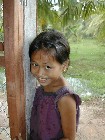 Cambodia – a land with history
…. and stories to tell
Cambodia – a land with history
…. and stories to tell
 Cambodia – a land with history
…. and stories to tell
Cambodia – a land with history
…. and stories to tell
Like many visitors to Cambodia , the urge to visit was created by tales of the famous Angkor Wat and its surrounding, intriguing temples. But that is only part of the story of Cambodia , and we decided to try to see a little more of modern Cambodia and learn more about the Khmer history.
To do all that we joined a travel group who specialise in trying to give visitors a more intimate experience of Cambodian life and people.
Our trip started in the capital – Phnom Penh . (PP) A city of 1.2 million, located at the confluence of two great rivers – the Mekong and Tonle Sap . A comfortably sized city, with a reassuring order in its numbered streets, and every so often a reminder of French colonialism in the architecture.
We stayed at a small Hotel, near the Independence Monument , which served wonderful morning coffee and was an easy place to sit and observe some of the street and evening life. But more of that later.
Much of the transport around the town is old and cars, motos and cycle- rickshaws compete for custom. The motos were scary and vied with cycle –rickshaws for the title of “Most Dangerous” form of transport. Under normal conditions traffic drove on the right side of the road, but there seemed to be a dizzying number of ‘exceptions'. Due to a singular lack of traffic lights, turning left across a full lane of 5-abreast motos and cars was heart-stoppingly scary. But to the moto driver it was the normal way of doing things. It was also normal practice for a moto or cycle-rickshaw to turn left but stay on the 'wrong' side of the road until an opportunity arose to cross onto the right side – effectively dividing the road into 4 alternating lanes. After the first few times this happened, it actually seemed a sensible idea. But without the speed limit of 30 kph in town, loads more accidents would be inevitable.
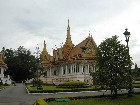 One afternoon we spent in cultural pursuits – visiting the
National Museum to see pre-Angkorian,
Angkorian and post-Angkorian statues and artifacts. A fascinating look at
how the influence of Hinduism, with its plethora of Gods and incarnations,
Buddhism and Cambodian styles evolved to create exotic sculptures and handiwork.
One afternoon we spent in cultural pursuits – visiting the
National Museum to see pre-Angkorian,
Angkorian and post-Angkorian statues and artifacts. A fascinating look at
how the influence of Hinduism, with its plethora of Gods and incarnations,
Buddhism and Cambodian styles evolved to create exotic sculptures and handiwork.
The Royal Palace houses a complex of golden roofed buildings and manicured gardens and our guide for this visit was a delightfully intense character who was an ardent monarchist and took enormous pride in showing off the Palace buildings to us. Lots of gold in the Hall of Audience, gold chairs, chandeliers – everything opulent. Another building The Silver Pagoda, had a solid silver tiled floor and case upon case of donated Buddha statues. Our earnest guide wanted us to see each and every dusty artifact. Woe betide whichever of us lost interest and wandered off! Discordant and arrogant a European style building sat in the middle of the Palace complex, totally out of character with all the other buildings. Donated by the French at the end of the C19.
“ Russian Market ” and shopping
Oh! how delightful foreign markets are! Full of new experiences, new foods, new artifacts, new bargaining practices, new smells and new shocks. Oh! how disgusting foreign markets are! Rats running past the diners feet at their tables, earthen floors, rubbish and stagnant water lying in the food markets.
The Russian Market in PP was no exception, but it was full of such wonderful stalls.
Silk, clothing and material stalls needed time for browsing, the ‘antiques' stalls with so many enticing objects of desire, the copy watches (my serious weakness), the bags and baggage stalls with their ‘North Face', ‘Jack Wolfskin', as well as Gucci, Prado, Chanel etc., the pirate software for computers – we loved it all. And especially bargaining for our purchases.
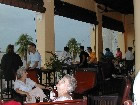 Overlooking the wide brown and muddy Mekong , nestled in a row of
buildings sits the FCC, the Foreign Correspondents
Club – the place for ex-pats and visitors to be seen
drinking and eating. Creaking with a faded colonial feel, it was noisy,
busy and haunted a little by its former unquiet days. Standing there with
an iced G+T, I felt almost an intruder, being neither a Foreign Correspondent
nor an ex-pat. But sitting in three big, comfortable wood and
leather armchairs were 3 ladies I immediately recognized as teachers – so I
spent a lovely 20 minutes chatting to them about their stay in Cambodia as
volunteers on the VSO scheme. They had been issued with white crash
helmets for riding around the country on motos, all of them had different skills
within education, which they were excited about ‘loaning' to Cambodia for 2
years – a great gift and a difficult ‘guess' as to which party would gain most
from the experience.
Overlooking the wide brown and muddy Mekong , nestled in a row of
buildings sits the FCC, the Foreign Correspondents
Club – the place for ex-pats and visitors to be seen
drinking and eating. Creaking with a faded colonial feel, it was noisy,
busy and haunted a little by its former unquiet days. Standing there with
an iced G+T, I felt almost an intruder, being neither a Foreign Correspondent
nor an ex-pat. But sitting in three big, comfortable wood and
leather armchairs were 3 ladies I immediately recognized as teachers – so I
spent a lovely 20 minutes chatting to them about their stay in Cambodia as
volunteers on the VSO scheme. They had been issued with white crash
helmets for riding around the country on motos, all of them had different skills
within education, which they were excited about ‘loaning' to Cambodia for 2
years – a great gift and a difficult ‘guess' as to which party would gain most
from the experience.
Phnom Penh was a French Protectorate at the end of the 1880's and they were responsible for the early canals, roads and buildings which made PP one of the most beautiful cities in Indochina by the 1920's. Independence from France was granted in 1953 but by 1975 the Khmer Rouge (KR) had taken control of the city.
Leading the KR with an ideology born out of a mix of very left wing politics absorbed during a stay in France and an admiration of Mao's “Great Leap Forward”, was Pol Pot. Throughout the terror of the four years until his final expulsion to Thailand , Pol Pot remained separate and aloof from some of the grisly reality of what was done in the name of his political vision.
(See Appendix 1.1 and Appendix 1.2)
We went to visit two of the most notorious places in that history – Tuol Sleng , the KR S-21 prison. A place of unimaginable terror and horror, now turned into a Museum for visitors. Photographs of some of the victims of the regime, graphic paintings (by a survivor} of some of the worst atrocities, iron bars and shackles, confinement in tiny individual cells, interrogation and torture rooms. On a bright but showery morning it was a time for reflection on how people can be empowered and given authority to commit such atrocities on others. Was it fanatically followed ideology, threats against self and family, pathological sadism, lack of basic education, fear of the alternative or social failure? Probably a complex mixture of all the above.
We walked around at our own pace, with our own thoughts, ending up in a quiet mood for coffee at the “Boddhi Tree” restaurant opposite the site.
The other place of horror known as “ The Killing Fields ” was 15 km of atrocious muddy and pot-holed road outside Phnom Penh . At the centre stood an elegant glass and marble Monument full of layer upon layer of skulls and bones, while all around the (now) grassy pits were evidence of where thousands of bodies had been buried. Only 43 out of around 125 pits have been opened, the rest stay untouched. The manner of death for most of the victims is indescribable. Birdsong was a poignant and welcome reminder of life and joy.
The three ladies in our group had arranged for a “ Seeing Hands ” blind massage, but we had to go by ‘cyclo'. Quite a scary operation going into the traffic vulnerably perched in a rickety pram! The key is not to panic or change speed or direction suddenly. The blind masseuses were ready for us so we changed into white pyjamas and lay on the tables, ready. Smooth music in the background accompanied less than gentle pressure point ‘digging'. Arms, forearms, fingers neck, head, back, legs etc – all rhythmically pushed and prodded for an hour until a finale of whacking and slapping. All for $3! These blind people learn how to massage and can support themselves – having up to 10 clients each a day. Hard work though.
Back to the Hotel to find that the Travel Wash tube had squished itself open and contaminated the black hold-all and that I had been bitten,mercilessly, by some nasty bug all around my midriff – about 30 seriously itchy bites, that irritated for days.
 Thousands of children are either orphaned or simply economic problems
for their families and so are left to their own devices on the streets of large
towns. In PP there is one charity called “ Friends
” which aims to help re-integrate some of these street children into
society. “Friends” runs a fascinating restaurant staffed by young
street children, after they have had training, where the menu is a mix of
western and local, and the food is so good that this is THE place to eat at
lunchtime. Through “Friends” 1600 street children are helped every day –
with accommodation, schooling, vocational training, life skills training (for
which read HIV/AIDS and drug at the top of the list) and a little bit of hope.
Thousands of children are either orphaned or simply economic problems
for their families and so are left to their own devices on the streets of large
towns. In PP there is one charity called “ Friends
” which aims to help re-integrate some of these street children into
society. “Friends” runs a fascinating restaurant staffed by young
street children, after they have had training, where the menu is a mix of
western and local, and the food is so good that this is THE place to eat at
lunchtime. Through “Friends” 1600 street children are helped every day –
with accommodation, schooling, vocational training, life skills training (for
which read HIV/AIDS and drug at the top of the list) and a little bit of hope.
Recently HIV/ AIDS has had a devastating impact on the country, there are worrying trends in child prostitution and sex is a commodity that sells for $5. Our Hotel in PP was very close to a main boulevard with central park and nightly we were told there could be anything up to 2000 prostitutes walking their wares around. (See Appendix 7)
In a small town (Kampot) on our way to Kep - sur - Mer , we had a coffee stop in a typical open-style restaurant with about 15 pretty girls serving at the tables. All were available for $2 - $5, all hoping that a trip upstairs with a businessman would turn into a ticket to a better life. On the wall two rather saccharine posters – one of a ‘Princess' and the other a typical ‘Southern Belle' circa Scarlett O'Hara, maybe gave them a mixture of optimism and hope?
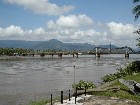 To retreat from heat and humidity, the richer city dwellers and the
colonials used to drive to Kep sur Mer via the happy little town of
Kampot .
To retreat from heat and humidity, the richer city dwellers and the
colonials used to drive to Kep sur Mer via the happy little town of
Kampot .
The start of our day was fine and we reached the wonderful coastline, green shrub-covered banks dropping down to a glorious blue sea. But then the rain came and as we walked down to the shore it quite thundered down as the accumulated water on the hills rushed towards the sea. The old colonial houses still stand in prime position along the coast, but time has blackened their walls, vegetation has reclaimed dominance and returned gardens to their natural untidiness. The villas look a sad relic of the past. For some, it seems, the renovators are moving in and even Hotels are planned for the area. A pity our day saw the place in shades of grey rather than bright sunshine technicolour.
The overnight accommodation was at a Khmer Homestay , a wonderfully peaceful and elegant house. The terrace was perfectly situated, its view of the river and surrounding green hills – a delightful place to eat our hostess's exquisite herb-coated freshwater fish with lemongrass sauce.
Back to PP, through endless green rice fields dotted with tall palms and via the “Knocking Shop” Restaurant for lunch - $3 each!
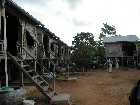 Battambang is the second largest town in Cambodia and
surrounded by beautiful countryside and it was here that we became acquainted
with our own helmets and moto drivers. Clinging rather anxiously to my
small Cambodian driver, we sped off, (it was probably a very sedate ‘sped') to
visit The Coconut House
Project where homeless families are housed for up to 6
months. At the project they learn a variety of skills – cooking, basket
weaving, rattan furniture making, sewing, and house construction. The aim
is to promote self-sufficiency and each family looks after 6 hens and lives in
simple accommodation – all neat and quietly organized. Women cooked
aubergines and morning glory (a green vegetable) over primitive stoves while the
men made rattan furniture and the younger children were in classrooms having
lessons.
Battambang is the second largest town in Cambodia and
surrounded by beautiful countryside and it was here that we became acquainted
with our own helmets and moto drivers. Clinging rather anxiously to my
small Cambodian driver, we sped off, (it was probably a very sedate ‘sped') to
visit The Coconut House
Project where homeless families are housed for up to 6
months. At the project they learn a variety of skills – cooking, basket
weaving, rattan furniture making, sewing, and house construction. The aim
is to promote self-sufficiency and each family looks after 6 hens and lives in
simple accommodation – all neat and quietly organized. Women cooked
aubergines and morning glory (a green vegetable) over primitive stoves while the
men made rattan furniture and the younger children were in classrooms having
lessons.
One classroom was full of girls learning to sew and use treadle machines. About 30 machines in rows. The young girls were all concentrating on one aspect or another of making garments, and I was happily taking pictures when Mark told me that they were all rape victims. Sometimes incest, apparently a problem in rural areas.
The other classrooms were all fitted out with desks and chairs but I didn't see many books and pens for the young children to use for drawing or writing. But overall it left us all with a very positive feeling - that there are people prepared to give time and compassion to others in need.
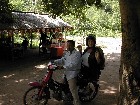 Our moto drivers were always there to take us on to the next place – a
lunch stop or a trundle through the local countryside to an old temple.
Small narrow, dry paths curved around potholes and passed shacks , rice fields,
little communities where the majority of people were lying in hammocks under the
main part of the houses. In the countryside most were wearing
sarong/lunghi style clothes. We sped along Road 10 – a red and
dusty road, until in the distance we saw our goal – a high hill with a temple on
the top.
Our moto drivers were always there to take us on to the next place – a
lunch stop or a trundle through the local countryside to an old temple.
Small narrow, dry paths curved around potholes and passed shacks , rice fields,
little communities where the majority of people were lying in hammocks under the
main part of the houses. In the countryside most were wearing
sarong/lunghi style clothes. We sped along Road 10 – a red and
dusty road, until in the distance we saw our goal – a high hill with a temple on
the top.
Steps. Heat. Sweat. Steps. Heat. Sweat. Slowly we made our way up to the top, outpaced by some young urchins asking us “What's your name?”, until we reached the summit and a tatty temple plus stupa, ragged prayer flags and a couple of simple stalls.
Our guide, Mr. Ro, talked to us of his personal experiences of the Khmer Rouge era. He was about 9 and lived in PP with his ‘relatively affluent' parents – both intellectuals. The family was sent out to the countryside around Battambang where they were separated. His father was taken back to Tuol Sleng, tortured and died there. Two of his brothers met their death around Battambang – maybe thrown down a deep natural pit to a cave below. We walked to the cave and climbed inside to look up and see the opening around which KR stood laughing as they threw people to their deaths. Some were still alive after falling, children were thrown into a deeper cave. A container of broken bones and skulls stood silently for the 50,000 who were killed there. Cool and dark, the place held chilling memories.
The next day we were off again on our trusty motos to another hill and temple. Past naked, waving children, small banana-leaf and bamboo houses with attendant pigs and speedy, ‘racing' chickens. At our first village stop I decided to give out my small stock of biros to 7 children, within an eye blink, there were 2 more and then another 6. Luckily, Jean came to my rescue with some more pens, our reward being delightful grins from all the small faces.
This C10 Buddhist temple was up loads more tiring steps, everywhere plastic rubbish strewn around. At various times the temple had fallen down and then been reconstructed but without the precision of an archaeological team – leaving some of the carved designs haphazard and muddled. How knee-crunching was the climb down.
Back on to the motos and to the Bamboo Train for the return to Battambang.
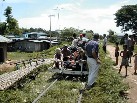 I'm not sure I knew what to expect, but it wasn't what we found .
The train track from Battambang to PP (or it could be SR) is used by
locals for carrying goods and passengers; the ‘train' is made up of 2 metal
axles onto which is maneuvered a bamboo platform and a small engine with rubber
fan belt whizzes the whole thing into rattling action. The motos
were piled on one of the quickly assembled trains and we sat on the bamboo floor
of the other. It was wonderful – I got totally overexcited as we
raced headlong so close to the ground, the wind blowing hair awry – over scary
bridges, the thwack of metal on metal as we passed over the joints on the rails.
The noise was deafening, and it was impossible not to shout
“Whoo-whoo-whooooo!” with the exhilaration of it all.
I'm not sure I knew what to expect, but it wasn't what we found .
The train track from Battambang to PP (or it could be SR) is used by
locals for carrying goods and passengers; the ‘train' is made up of 2 metal
axles onto which is maneuvered a bamboo platform and a small engine with rubber
fan belt whizzes the whole thing into rattling action. The motos
were piled on one of the quickly assembled trains and we sat on the bamboo floor
of the other. It was wonderful – I got totally overexcited as we
raced headlong so close to the ground, the wind blowing hair awry – over scary
bridges, the thwack of metal on metal as we passed over the joints on the rails.
The noise was deafening, and it was impossible not to shout
“Whoo-whoo-whooooo!” with the exhilaration of it all.
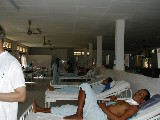 Later that day we visited the Emergency Hospital
(Life support for civilian war victims - an Italian Charity )
Started in Cambodia in 1997/8 to help landmine victims with
specialist orthopaedic and reconstructive surgery, the Hospital was run by a
Finnish Doctor (Ake) and he kindly took time out of a busy schedule to show us
around. We saw the Receiving Bay , where people are seen and assessed,
cleansed and treatment is discussed. Many people present with amazing
limb deformities e.g. club foot, and this is now one of the forefront Hospitals
for reconstructive orthopaedic surgery. They also perform routine
surgical excision of goitre, which is endemic in the area.
Later that day we visited the Emergency Hospital
(Life support for civilian war victims - an Italian Charity )
Started in Cambodia in 1997/8 to help landmine victims with
specialist orthopaedic and reconstructive surgery, the Hospital was run by a
Finnish Doctor (Ake) and he kindly took time out of a busy schedule to show us
around. We saw the Receiving Bay , where people are seen and assessed,
cleansed and treatment is discussed. Many people present with amazing
limb deformities e.g. club foot, and this is now one of the forefront Hospitals
for reconstructive orthopaedic surgery. They also perform routine
surgical excision of goitre, which is endemic in the area.
We saw the Blood Room, for holding sachets of various blood groups used in transfusions; a small Laboratory; an X-Ray room and 2 Operating Theatres (sterile, so we didn't go inside). Finally on to the Wards: an IT Unit, which was not particularly high-tech, but a nurse was always present for the 4 beds. The Men's Ward was laid out (unashamedly, Ake said) like a Florence Nightingale Ward. 40 beds in 4 rows, no privacy curtains – but eminently practical for nursing staff. That day the patients included18:29 15/01/2004 a young lad with 3 fingers blown off each hand by a landmine, 2 goitre operations and a few moto accident victims. As roads improve, so speed increases and moto accidents are more frequent. There were fewer women in the Women's Ward; 2 children in wheelchairs, and a small girl in bright green wellies running with her club feet pointing inwards. “ Emergency' started with 7 foreign Doctors and professional staff, this number is now down to 2 as their aim is to teach enough skills to local people so that they can take over when ‘Emergency' finally leaves. We were all so impressed with the Hospital, its cleanliness and order, its caring staff and its commitment to the community.
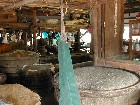 The “Cheese Factory” . Now this was odd, as we
had seen plenty of cattle on our travels but not one of them with a good-sized,
plumptious udder. So where did the milk come from for the cheese?
Puzzled, we trundled some more on our motos, finally crossing the
river on a dodgy-looking ferry to the Cheese Factory. Well, its not a
cheese smell assailing our noses, but a strong fishy pong.
Millions of tiny fish, chopped and mixed with spices and salt are packed tightly
into huge, old, wooden vats, where they can remain for up to a year. Men
were shovelling fork loads of the stuff into sacks, women were sitting on the
dirt floor chopping and mashing fish, neat piles of brown smoked fish and plenty
of offers to taste the stuff. If nothing else put you off,
the huge rubbish tip just feet away, was enough to deter even the bravest
stomach.
The “Cheese Factory” . Now this was odd, as we
had seen plenty of cattle on our travels but not one of them with a good-sized,
plumptious udder. So where did the milk come from for the cheese?
Puzzled, we trundled some more on our motos, finally crossing the
river on a dodgy-looking ferry to the Cheese Factory. Well, its not a
cheese smell assailing our noses, but a strong fishy pong.
Millions of tiny fish, chopped and mixed with spices and salt are packed tightly
into huge, old, wooden vats, where they can remain for up to a year. Men
were shovelling fork loads of the stuff into sacks, women were sitting on the
dirt floor chopping and mashing fish, neat piles of brown smoked fish and plenty
of offers to taste the stuff. If nothing else put you off,
the huge rubbish tip just feet away, was enough to deter even the bravest
stomach.
Siem Reap To get to Siem Reap we needed to use a new kind of transport – speed boats with 40hp engines. Baggage and people were divided onto two boats and we sped along the river, as local people were waking up and starting their day. Luckily the weather was fine and we sped along the river leaving an undulating wake to disturb those already out fishing. We passed small villages with weird cantilevered bamboo poles elegantly piercing the sky, used for fishing; through narrow channels clogged with water hyacinth, or similar plant, which choked the propellers, through rubbish and filth in the narrower parts of the river until the water cleared and spread out over the landscape - and we were in Tonle Sap Lake.
Along some of the narrower parts I had hoped to see some of the famous bird life on the Lake , but the noise of the approaching 40hp engines had warned anything with ears that we were approaching. We did see a few Pond Herons, Whiskered Terns, Cormorant and flocks of Myna birds picking insects from the water surface.
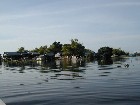 We paused in our race across the water at a
floating village for breakfast. Hot tea - but breakfast cooked by
the previous nights restaurant. The ‘docking' at Siem Reap was
muddy and congested, but our transporter van was plush and air-conditioned.
Siem Reap has made significant money from its treasures.
We paused in our race across the water at a
floating village for breakfast. Hot tea - but breakfast cooked by
the previous nights restaurant. The ‘docking' at Siem Reap was
muddy and congested, but our transporter van was plush and air-conditioned.
Siem Reap has made significant money from its treasures.
(Siem Reap) Foreign Correspondents Club for dinner. A totally different feel from the FCC in PP. Here it is a totally modern, stylish new building with a huge main room. At one end a functional, state-of-the-art kitchen , at the other a long Bar and in the middle pods of large comfy chairs for chatting and drinking. Each of the long sides had open arches leading onto wide balconies with dining tables. Beautifully done, and none of the ghosts of PP's FCC.
The Treasures of Angkor .
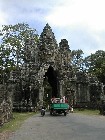 Early in the morning we went to the state-of–the-art entrance
to Angkor . $40 for a 3-day pass to the temples and the surrounding land,
for the Angkor site is vast. Each of us received a laminated Pass, with
photo, which we had to show at all temple entrances. A Private firm
in conjunction with the Government run the whole site, and with the
number of tourists expected to reach over 1 Million by 2004, there was need for
an efficient system. One just hopes the monies go into improving
site facilities, restoration of temples and maintenance costs.
Early in the morning we went to the state-of–the-art entrance
to Angkor . $40 for a 3-day pass to the temples and the surrounding land,
for the Angkor site is vast. Each of us received a laminated Pass, with
photo, which we had to show at all temple entrances. A Private firm
in conjunction with the Government run the whole site, and with the
number of tourists expected to reach over 1 Million by 2004, there was need for
an efficient system. One just hopes the monies go into improving
site facilities, restoration of temples and maintenance costs.
Angkor Thom (1190 – 1210) In
fact a great City, 3 km long on each side. A wide moat surrounds
the city, and as you approach through the main gateway you are ‘escorted' by
sculpted Deities and Giants. Sadly many of the heads have been looted,
many more eaten by weather and time. The southern
gateway is surmounted by four huge heads facing in each direction and then the
first temple to greet you is the magnificent Bayon Temple
(Late C12) sitting gloriously in the centre of Angkor Thom.
It's the stuff of photos, the stuff that draws the tourists, the stuff of
legend. 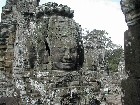
Giant stone faces smile enigmatically from each side of 37 towers, giving great photo opportunities in every direction. On the lower levels there are wonderful bas-reliefs of mighty battles between ancient Khmer and their Cham foes. One side were depicted with long hair and cruel faces, the other clean-cut with droopy ears. The bullock cart in the C12 bas relief could have been one still in use today. Mixed with the battle scenes were more ordinary ones - scenes from everyday life, cock-fighting, cooking, market scenes etc. A stunning start to the temples.
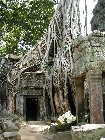 On to Ta Phrom (late C12) probably known to all
who have watched Angelina Jolie in “Tomb Raider' (As yet, I haven't.)
Originally a Buddhist Monastery and at one time enormously
wealthy, this is a darker temple complex, sprawling with massive invasion of
tree roots and jungle. The fig and silk-cotton trees tower over the
structures, but most remarkable are the masses of bare roots clinging to the
walls and towers. They look like a pit full of pythons let loose to
insinuate their way over the ancient carved stones. Do the trees hold up
the temples or the temples holds up the trees? A difficult call
sometimes. So very atmospheric and a brilliant photo spot.
On to Ta Phrom (late C12) probably known to all
who have watched Angelina Jolie in “Tomb Raider' (As yet, I haven't.)
Originally a Buddhist Monastery and at one time enormously
wealthy, this is a darker temple complex, sprawling with massive invasion of
tree roots and jungle. The fig and silk-cotton trees tower over the
structures, but most remarkable are the masses of bare roots clinging to the
walls and towers. They look like a pit full of pythons let loose to
insinuate their way over the ancient carved stones. Do the trees hold up
the temples or the temples holds up the trees? A difficult call
sometimes. So very atmospheric and a brilliant photo spot.
Lunchtime was interesting as we were assailed by a horde of children each with a range of trinkets to sell – postcards, Angkor books, tablecloths etc. “You buy from me?”, “What your name?” “You buy from Me later, OK?” They asked our names and Claire, being new to the begging children game, gave all ours. Next we were given hand written messages, in English with our names on them. We all took turns to talk to the children, mainly unschooled but able to turn phrases in English, French, German, Japanese. They followed and called to us when we had finished our tour, but most amazing of all was the next morning (up at sparrows – but more on that later) they were there again – “Where's Brian ?”, “He's still in bed”, “ He's very lazy!” What it is to have minds uncluttered by education.
In the afternoon sunlight we walked to the greatest temple of them all, Angkor Wat. The front aspect strikes rather austere and intimidating because it looms in the distance surrounded by a vast moat, across which one walks on a wide (12 ft at least) stone causeway. The causeway itself is a wondrous feat of construction, with huge blocks of paving edged by a carved Naga balustrade. (Naga = a mythological multi-headed snake) This causeway leads to a wide ‘Entrance' building with three doorways – 1 for the King, 1 for the people, and 1 for the elephants. Through that and you begin to approach the main temple area. Another long causeway (350 metres) with ponds and ‘libraries' symmetrically on each side. At last, ahead are the lotus-flower shaped towers of AW. Rather blackened by weathering, angular and sombre the main towers dominated the skyline. From this aspect you really only see 3 of the 5 towers – variously described as shaped like beehives, pineapples or rather more romantically, lotus flowers.
Inside the purpose of the building becomes apparent – it is a huge 3-tiered temple dedicated to Vishnu. Running round the exterior first floor walls is a 12ft. high bas relief relating to the Mahabarata and Ramayana, stories of Hindu Gods and mythology. Probably the most famous of them all is the “Churning of the Ocean of Milk ” a depiction of the Gods and Demons churning the ocean for treasures. (See Appendix 3 for the proper story) Some wonderfully fine carving of apsara dancers all with different hairstyles adorn the walls, too. This first level of the temple was for ordinary (probably illiterate) people to come to, to learn the stories of their Gods.
The second level was for priests and monks, and the top level just for the King and his High Priests. Up there were 4 statues of Buddha and glorious views of the surrounding temple complex. I didn't go. I didn't feel like being a High Priest and climbing a set of dangerously steep stone steps, where only one handrail was available. Rather watch the chaos of others getting into difficulty.
So much to take in on one visit, so we decide to return very early the next
morning in time for “ Sunrise over Angkor ” 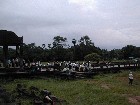
A 4.30 wake-up call. Walked over the first causeway with torchlight to settle for a spot on the inside wall of the Entrance Building – along with around 250 others. Some with tripods, expensive cameras and attendant zoom lenses – and we waited and waited – a sight pinkness flushed the sky and a gradual lightening but NO SUN over Angkor that morning. Bit disappointing really. Had to make do with photos of people sitting, waiting.
Banteay Srey (967)
Yet another temple, earlier, much smaller in scale, altogether more delicate. Surrounded by lovely countryside, this temple is a delightful gem.
Detailed carving on the Entrance Gate which opens onto a moat with water lilies and in the centre a range of temple buildings. (So like the early temples in India ) Up close the carving here was different, toothy lions adorned entrances, apsara dancers had even more voluptuous figures than at AW, carvings were energetic, lively and sumptuous, and they covered every square cm. of pink sandstone wall. We were lucky that the sun shone on the sandstone giving it a mellow beauty despite some discolouration in this climate; the trees were full of birdsong and there weren't many visitors around.
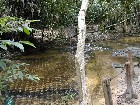 The next part of this day entailed going a further 30 km along
a muddy, potholed road towards Mount Kulen and
the River of One
Thousand Linga . A really
ancient site where Jayavarman ll, in 802 AD declared himself the sacred
“Universal Monarch”. As self-styled “King of Kings” and also
“God King” he was able to declare Cambodia independent and unified.
He had a fixation with linga (the phallus shaped object that
represents the creative energies and power of nature as well as being the symbol
for Shiva) and had hundreds of linga chiseled into the river bed of the Siem
Reap River . It was believed that the linga ‘fertilised' the waters that
irrigated the rice fields below. There are also some ancient carvings in
the river bed – one sadly defaced earlier this year.
The next part of this day entailed going a further 30 km along
a muddy, potholed road towards Mount Kulen and
the River of One
Thousand Linga . A really
ancient site where Jayavarman ll, in 802 AD declared himself the sacred
“Universal Monarch”. As self-styled “King of Kings” and also
“God King” he was able to declare Cambodia independent and unified.
He had a fixation with linga (the phallus shaped object that
represents the creative energies and power of nature as well as being the symbol
for Shiva) and had hundreds of linga chiseled into the river bed of the Siem
Reap River . It was believed that the linga ‘fertilised' the waters that
irrigated the rice fields below. There are also some ancient carvings in
the river bed – one sadly defaced earlier this year.
Back along the pock-marked muddy road through countryside, past small houses with grubby children, muddy buffalo, wallowing pigs, scratching dogs, ragged chickens all making a strangely picturesque scene.
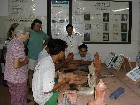 In Siem Reap we went to see Artisans
d'Angkor , a practical school set up to teach some of
the old, traditional skills of carving in wood and stone, lacquer-work,
polychrome painting etc. Young students were working at personal projects
while all the time visitors walked around looking over their shoulders.
The last part was a beautifully presented Shop full of artifacts
made in the workshops, but having been round the local markets the goods were
highly priced and it didn't seem right to haggle.
In Siem Reap we went to see Artisans
d'Angkor , a practical school set up to teach some of
the old, traditional skills of carving in wood and stone, lacquer-work,
polychrome painting etc. Young students were working at personal projects
while all the time visitors walked around looking over their shoulders.
The last part was a beautifully presented Shop full of artifacts
made in the workshops, but having been round the local markets the goods were
highly priced and it didn't seem right to haggle.
Finally I will mention the Mine Museum which we went to see. A young Cambodian who lost both of his parents in the time of the KR now spends all his energies in ‘de-mining' and has set up an information centre to tell of the problems and threats that land mines pose. He also takes in and educates some young victims of landmines. There were loads of anti-personnel mines with descriptions of how they worked – mines from USA, Russia, Vietnam, UK, China … and hand written stories illustrated graphically the horror of land mines. (See Appendix 2 for a link to a Land mine site)
The final trip was back from Siem Reap to PP by minibus.
Very quickly we were into green flat countryside, with the now familiar houses on stilts, pigs wallowing, buffalo muddying, cows munching, chickens pecking, dogs scratching and the road was excellent. We passed kids playing in muddy rivers, fishermen with round weighted nets catching tiny 3 – 4inch fish. We passed buffalo carts looking just like Constable's “Haywain” picture, cycles, motos, pick-up trucks with goods and umpteen people ….
Joke: How many people can you fit in a Cambodian pick-up truck? Answer “One more!” The squashed passengers looked windswept and uncomfortable, cramped and hot. There were chickens and pigs being taken to market; the chickens strung by their legs upside down in ‘bunches' of 10's until the moto driver was surrounded with a living feathery cushion and the pigs were strapped immobile into woven bamboo baskets, lying upside down behind the moto driver. According to one source the pigs are drugged with marijuana before being transported. Lucky Pigs?
Rivers and ample rain water are life-blood to the Cambodians; they mean food, transport, livelihoods, laundry, fishing, recreation, sewers and dumping grounds. The Mekong and the Tonle Sap are the two main rivers, but we crossed many streams where there were often small children playing in the water, or fishermen angling for a catch. Tonle Sap lake is the largest freshwater lake in S E Asia, and is livelihood for many. Its floating villages easily adjust to the rising and falling of lake levels and commerce is conducted by boat. It is an important water bird sanctuary, too. (See Appendix 4 – a translation)
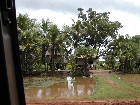 The west part of the country that we saw is flat and rice
fields predominate. Simple wooden housing is nearly always built
on stilts to allow for the copious rainfall, and in front of many of the village
houses was a small fish pond. Self sufficiency is evident by the number
of chickens, pigs and cattle that we saw tethered outside houses.
The west part of the country that we saw is flat and rice
fields predominate. Simple wooden housing is nearly always built
on stilts to allow for the copious rainfall, and in front of many of the village
houses was a small fish pond. Self sufficiency is evident by the number
of chickens, pigs and cattle that we saw tethered outside houses.
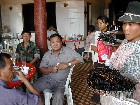 We stopped for lunch in The Spider Eating Capital of the World
- Skuon . It's a muddy little
market town and as soon as the minibus stopped we were assailed by three women
shouldering great dishes of blackened, roasted spiders. My reaction
was predictable, shiver down the spine and flee. At a safe distance,
I waited warily while our lunch table was cleaned and the underneath was swept
of discarded black spider legs and serviettes. The eating of
spiders is a left-over from KR days when the population were starving, without
money and they found the large Tarantula – type spiders gave them some
desperately needed food. Now, spider eating is considered a
bit of an acquired delicacy.
We stopped for lunch in The Spider Eating Capital of the World
- Skuon . It's a muddy little
market town and as soon as the minibus stopped we were assailed by three women
shouldering great dishes of blackened, roasted spiders. My reaction
was predictable, shiver down the spine and flee. At a safe distance,
I waited warily while our lunch table was cleaned and the underneath was swept
of discarded black spider legs and serviettes. The eating of
spiders is a left-over from KR days when the population were starving, without
money and they found the large Tarantula – type spiders gave them some
desperately needed food. Now, spider eating is considered a
bit of an acquired delicacy.
Not for our party though!
Our visit was organised extremely well by
Mark and Debbie of Carpe Diem Travel Limited (See Appendix 6)
and most gratefully and enjoyably received.
Appendix 1.2 – Dith Pran Holocaust Awareness Project
Appendix 2 – Link to a landmines site
Appendix 3 – Churning of the Sea of Milk
Appendix 4 – Tonle Sap (a translation)
Appendix 5 – What is a charitable heart?
Appendix 6 – Debbie Watkins “ Cambodia , a country with a fascinating past and a new future”
Appendix 7 – HIV AIDS problems / Beer girls
Photo Album